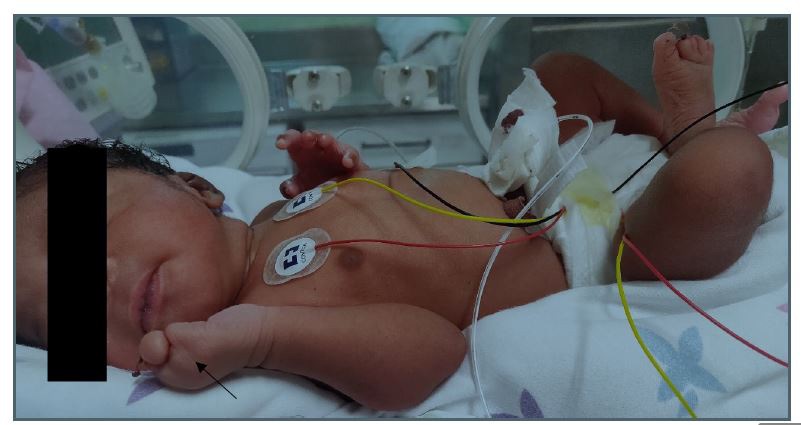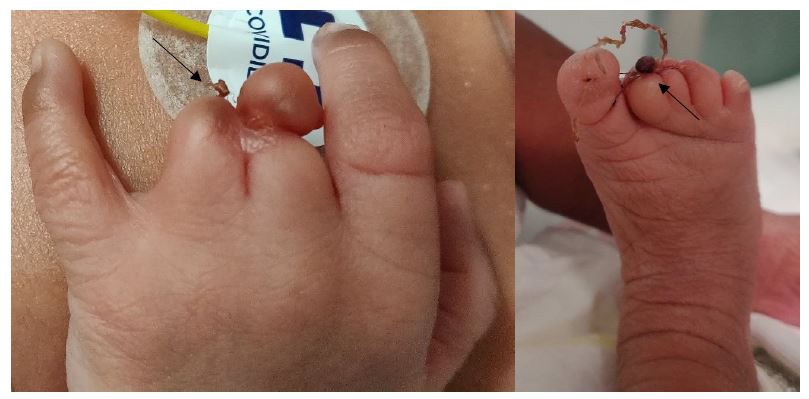
Journal of Clinical Images and Medical Case Reports
ISSN 2766-7820
Case Report - Open Access, Volume 2
Amniotic band sequence
Joana Lira1; Isabel Ayres Pereira1; Joana Soares Reis1; Marina Amaral2; Anabela Gomes3
1 Pediatrics Department, Centro Hospitalar de Vila Nova de Gaia/Espinho, Vila Nova de Gaia, Portugal.
2 Pediatric Surgery Department, Centro Hospitalar de Vila Nova de Gaia/Espinho, Vila Nova de Gaia, Portugal.
3 Neonatology Unit, Pediatrics Department, Centro Hospitalar de Vila Nova de Gaia/Espinho, Vila Nova de Gaia, Portugal.
*Corresponding Author: Joana Terroso Lira
Centro Hospitalar Vila Nova de Gaia e Espinho,
Serviço de Pediatria Médica, Rua Dr. Francisco Sá
Carneiro, 4400-129 Vila Nova de Gaia, Portugal.
Email: joana.lira@chvng.min-saude.pt
Received : Dec 09, 2021
Accepted : Jan 04, 2022
Published : Jan 11, 2022
Archived : www.jcimcr.org
Copyright : © Lira JT (2021).
Citation: Lira JT, Pereira IA, Reis JS, Amaral M, Gomes A. Amniotic band sequence. J Clin Images Med Case Rep. 2022; 3(1): 1545.
Clinical image description
A 33 weeks preterm female weighting 1945 g was born to a 28-year-old gravida 2 para 1. Pregnancy was surveilled in Angola with two ultrasounds performed at 12 and 23 weeks reported as normal. Emergent cesarean section was performed due to severe fetal bradycardia in context of a maternal sepsis. She was born depressed and was immediately intubated, with good response (AS 2/5/7) being off mechanical ventilation 1 hour later. Her clinical examination revealed multiple distal deformities in all the four limbs (Figures 1-3), being possible to observe syndactyly and amputation phenomena. Small constricting strings were visible, attached to the distal extremities. At day 1 she was observed by a pediatric surgeon that excised the constricting bands in some of the fingers. She was discharged from the hospital at day 24 and at her 3 months’ appointment she had a normal development and maintained her surveillance by a multidisciplinary team that includes an orthopedic surgeon.
Amniotic band sequence is a rare entity that comprises a broad spectrum of congenital defects. Depending on location and depth of the bands and timing of its appearance, different segments might be affected. Limbs are predominantly involved but craniofacial, abdominal and spinal defects can also occur [1].
There is no consensus on the etiology. The most widespread theory implies, as primary mechanism, rupture of the amnion in early pregnancy resulting in multiple loose strands (amniotic bands) that adhere to or entangle the fetus, compromising until then normally developed structures, leading in severe cases, to vascular disruption and subsequent autoamputation [1].
Mother’s consumptions also appear to be an important risk factor [2].
Diagnosis, that may be suspected in the first trimester and it is possible through detailed and serial ultrasound examination [3], is crucial so that timely in utero lysis of constriction rings can be offered, in order to restore normal perfusion and prevent amputation [4].
Declarations
Author contribution statement: All authors participated in the treatment of this case, and the first author drafted the manuscript. All authors read and approved the final manuscript.
Conflict of interest: The authors declare no conflicts of interest.
Funding statement: This study has no funding
References
- Seeds JW, Cefalo RC, Herbert WN. Amniotic band syndrome. Am J Obstet Gynecol. 1982; 144(3): 243-8.
- Cignini P, Giorlandino C, Padula F, Dugo N, Cafà EV, Spata A. Epidemiology and risk factors of amniotic band syndrome, or ADAM sequence. J Prenat Med. 2012; 6(4): 59-63.
- Barzilay E, Harel Y, Haas J, Berkenstadt M, Katorza E, Achiron R, Gilboa Y. Prenatal diagnosis of amniotic band syndrome - risk factors and ultrasonic signs. J Matern Fetal Neonatal Med. 2015; 28(3): 281-3.
- Javadian P, Shamshirsaz AA, Haeri S, Ruano R, Ramin SM, Cass D, Olutoye OO, Belfort MA. Perinatal outcome after fetoscopic release of amniotic bands: A single-center experience and review of the literature. Ultrasound Obstet Gynecol. 2013; 42(4): 449-55.


